Dairy Industry Sustainability Challenges
VerifiedAdded on 2020/03/07
|12
|3415
|114
AI Summary
This assignment delves into the pressing sustainability challenges confronting the dairy industry. It examines key issues such as environmental impact, resource management, animal welfare, and economic viability. The analysis draws upon various research studies and reports to highlight the drivers, barriers, and potential solutions for enhancing the sustainability of dairy production systems.
Contribute Materials
Your contribution can guide someone’s learning journey. Share your
documents today.
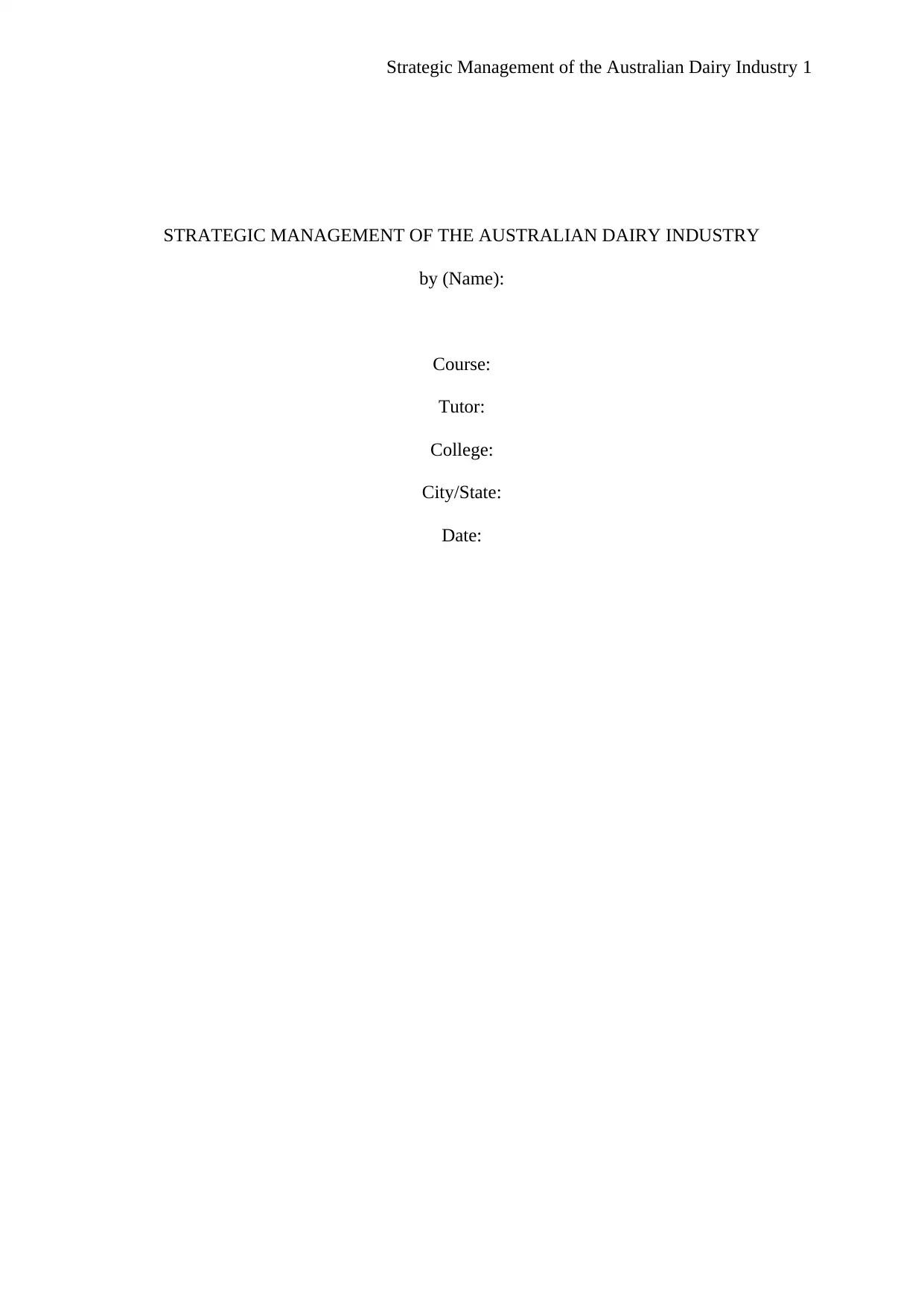
Strategic Management of the Australian Dairy Industry 1
STRATEGIC MANAGEMENT OF THE AUSTRALIAN DAIRY INDUSTRY
by (Name):
Course:
Tutor:
College:
City/State:
Date:
STRATEGIC MANAGEMENT OF THE AUSTRALIAN DAIRY INDUSTRY
by (Name):
Course:
Tutor:
College:
City/State:
Date:
Secure Best Marks with AI Grader
Need help grading? Try our AI Grader for instant feedback on your assignments.
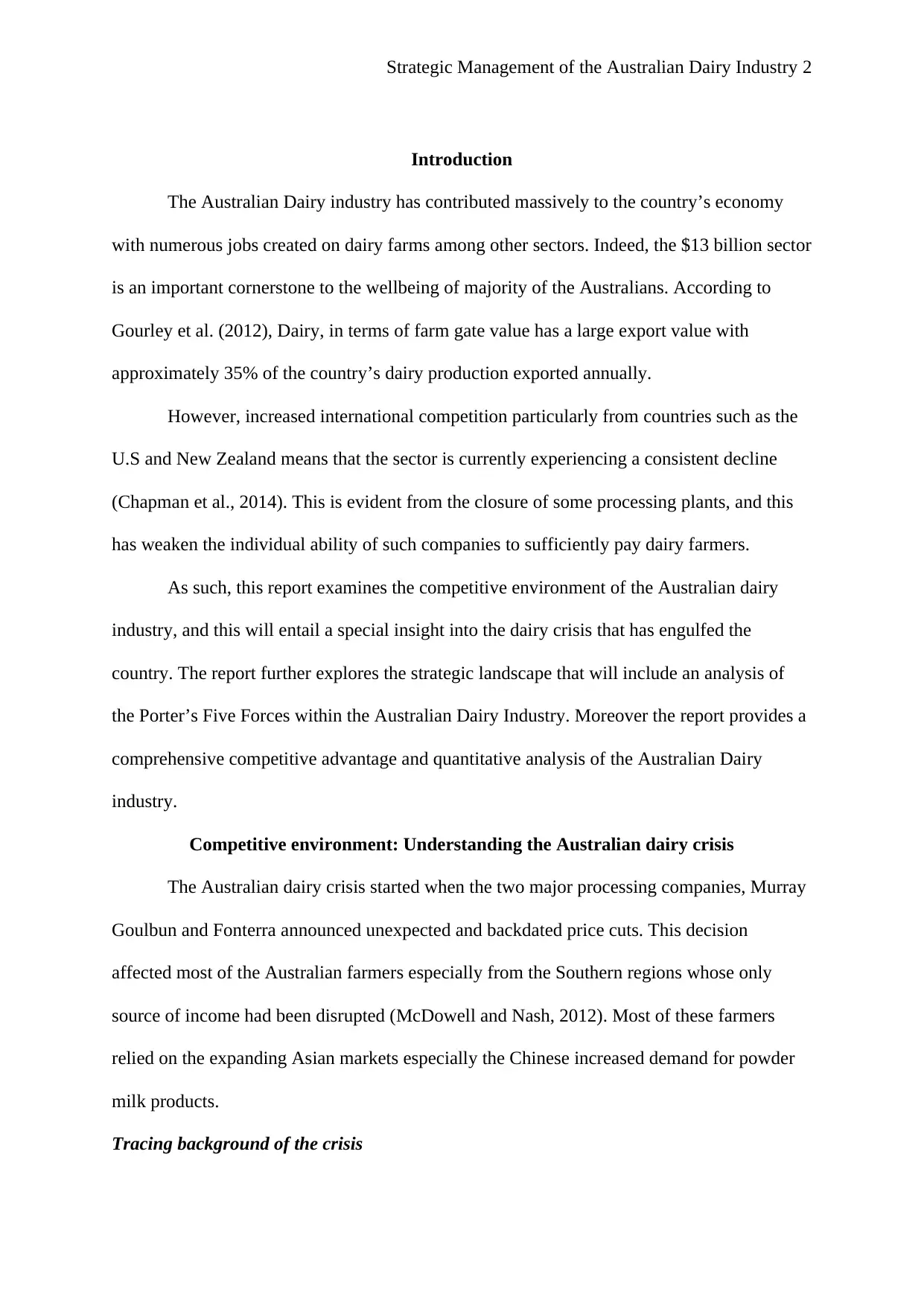
Strategic Management of the Australian Dairy Industry 2
Introduction
The Australian Dairy industry has contributed massively to the country’s economy
with numerous jobs created on dairy farms among other sectors. Indeed, the $13 billion sector
is an important cornerstone to the wellbeing of majority of the Australians. According to
Gourley et al. (2012), Dairy, in terms of farm gate value has a large export value with
approximately 35% of the country’s dairy production exported annually.
However, increased international competition particularly from countries such as the
U.S and New Zealand means that the sector is currently experiencing a consistent decline
(Chapman et al., 2014). This is evident from the closure of some processing plants, and this
has weaken the individual ability of such companies to sufficiently pay dairy farmers.
As such, this report examines the competitive environment of the Australian dairy
industry, and this will entail a special insight into the dairy crisis that has engulfed the
country. The report further explores the strategic landscape that will include an analysis of
the Porter’s Five Forces within the Australian Dairy Industry. Moreover the report provides a
comprehensive competitive advantage and quantitative analysis of the Australian Dairy
industry.
Competitive environment: Understanding the Australian dairy crisis
The Australian dairy crisis started when the two major processing companies, Murray
Goulbun and Fonterra announced unexpected and backdated price cuts. This decision
affected most of the Australian farmers especially from the Southern regions whose only
source of income had been disrupted (McDowell and Nash, 2012). Most of these farmers
relied on the expanding Asian markets especially the Chinese increased demand for powder
milk products.
Tracing background of the crisis
Introduction
The Australian Dairy industry has contributed massively to the country’s economy
with numerous jobs created on dairy farms among other sectors. Indeed, the $13 billion sector
is an important cornerstone to the wellbeing of majority of the Australians. According to
Gourley et al. (2012), Dairy, in terms of farm gate value has a large export value with
approximately 35% of the country’s dairy production exported annually.
However, increased international competition particularly from countries such as the
U.S and New Zealand means that the sector is currently experiencing a consistent decline
(Chapman et al., 2014). This is evident from the closure of some processing plants, and this
has weaken the individual ability of such companies to sufficiently pay dairy farmers.
As such, this report examines the competitive environment of the Australian dairy
industry, and this will entail a special insight into the dairy crisis that has engulfed the
country. The report further explores the strategic landscape that will include an analysis of
the Porter’s Five Forces within the Australian Dairy Industry. Moreover the report provides a
comprehensive competitive advantage and quantitative analysis of the Australian Dairy
industry.
Competitive environment: Understanding the Australian dairy crisis
The Australian dairy crisis started when the two major processing companies, Murray
Goulbun and Fonterra announced unexpected and backdated price cuts. This decision
affected most of the Australian farmers especially from the Southern regions whose only
source of income had been disrupted (McDowell and Nash, 2012). Most of these farmers
relied on the expanding Asian markets especially the Chinese increased demand for powder
milk products.
Tracing background of the crisis
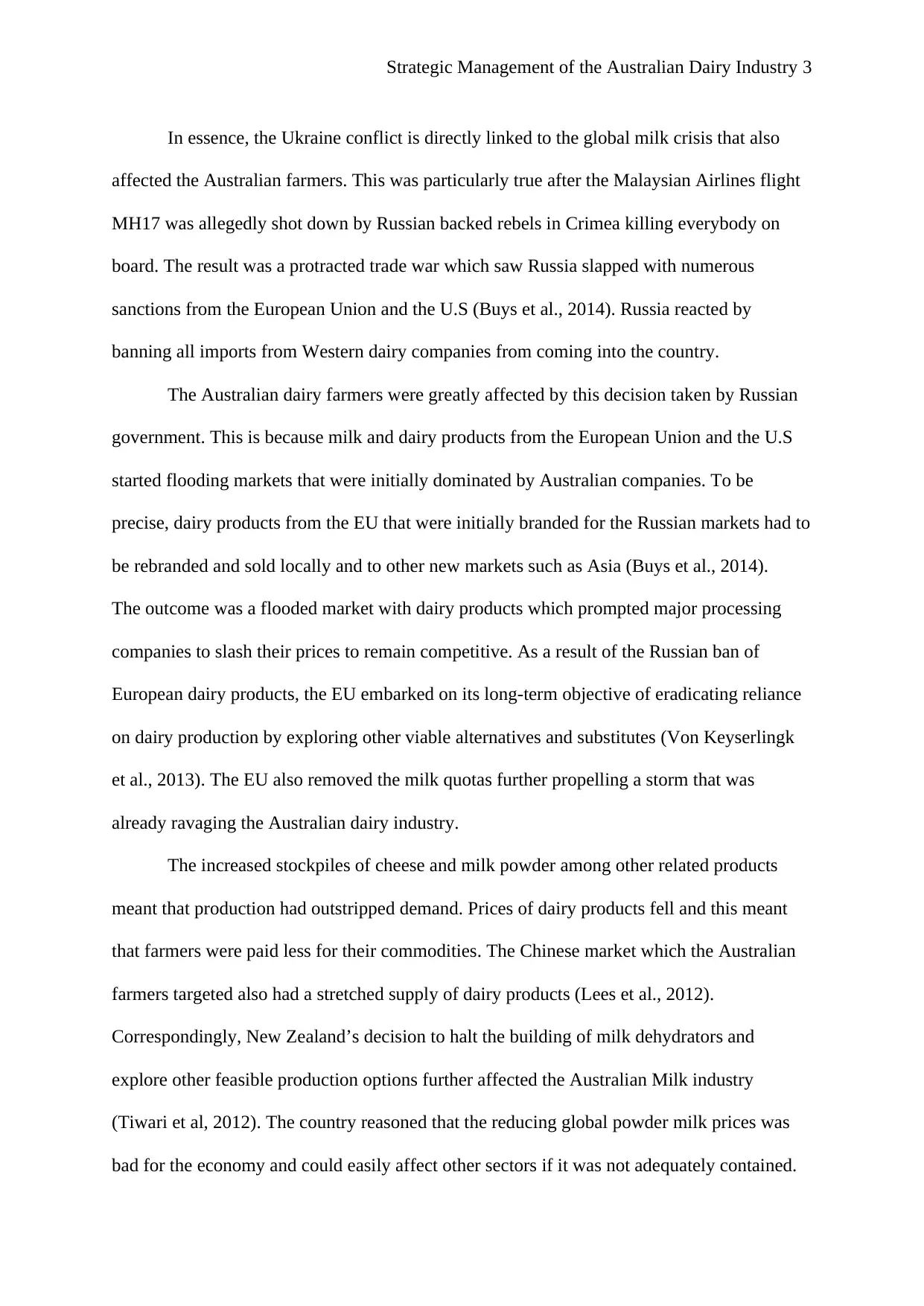
Strategic Management of the Australian Dairy Industry 3
In essence, the Ukraine conflict is directly linked to the global milk crisis that also
affected the Australian farmers. This was particularly true after the Malaysian Airlines flight
MH17 was allegedly shot down by Russian backed rebels in Crimea killing everybody on
board. The result was a protracted trade war which saw Russia slapped with numerous
sanctions from the European Union and the U.S (Buys et al., 2014). Russia reacted by
banning all imports from Western dairy companies from coming into the country.
The Australian dairy farmers were greatly affected by this decision taken by Russian
government. This is because milk and dairy products from the European Union and the U.S
started flooding markets that were initially dominated by Australian companies. To be
precise, dairy products from the EU that were initially branded for the Russian markets had to
be rebranded and sold locally and to other new markets such as Asia (Buys et al., 2014).
The outcome was a flooded market with dairy products which prompted major processing
companies to slash their prices to remain competitive. As a result of the Russian ban of
European dairy products, the EU embarked on its long-term objective of eradicating reliance
on dairy production by exploring other viable alternatives and substitutes (Von Keyserlingk
et al., 2013). The EU also removed the milk quotas further propelling a storm that was
already ravaging the Australian dairy industry.
The increased stockpiles of cheese and milk powder among other related products
meant that production had outstripped demand. Prices of dairy products fell and this meant
that farmers were paid less for their commodities. The Chinese market which the Australian
farmers targeted also had a stretched supply of dairy products (Lees et al., 2012).
Correspondingly, New Zealand’s decision to halt the building of milk dehydrators and
explore other feasible production options further affected the Australian Milk industry
(Tiwari et al, 2012). The country reasoned that the reducing global powder milk prices was
bad for the economy and could easily affect other sectors if it was not adequately contained.
In essence, the Ukraine conflict is directly linked to the global milk crisis that also
affected the Australian farmers. This was particularly true after the Malaysian Airlines flight
MH17 was allegedly shot down by Russian backed rebels in Crimea killing everybody on
board. The result was a protracted trade war which saw Russia slapped with numerous
sanctions from the European Union and the U.S (Buys et al., 2014). Russia reacted by
banning all imports from Western dairy companies from coming into the country.
The Australian dairy farmers were greatly affected by this decision taken by Russian
government. This is because milk and dairy products from the European Union and the U.S
started flooding markets that were initially dominated by Australian companies. To be
precise, dairy products from the EU that were initially branded for the Russian markets had to
be rebranded and sold locally and to other new markets such as Asia (Buys et al., 2014).
The outcome was a flooded market with dairy products which prompted major processing
companies to slash their prices to remain competitive. As a result of the Russian ban of
European dairy products, the EU embarked on its long-term objective of eradicating reliance
on dairy production by exploring other viable alternatives and substitutes (Von Keyserlingk
et al., 2013). The EU also removed the milk quotas further propelling a storm that was
already ravaging the Australian dairy industry.
The increased stockpiles of cheese and milk powder among other related products
meant that production had outstripped demand. Prices of dairy products fell and this meant
that farmers were paid less for their commodities. The Chinese market which the Australian
farmers targeted also had a stretched supply of dairy products (Lees et al., 2012).
Correspondingly, New Zealand’s decision to halt the building of milk dehydrators and
explore other feasible production options further affected the Australian Milk industry
(Tiwari et al, 2012). The country reasoned that the reducing global powder milk prices was
bad for the economy and could easily affect other sectors if it was not adequately contained.
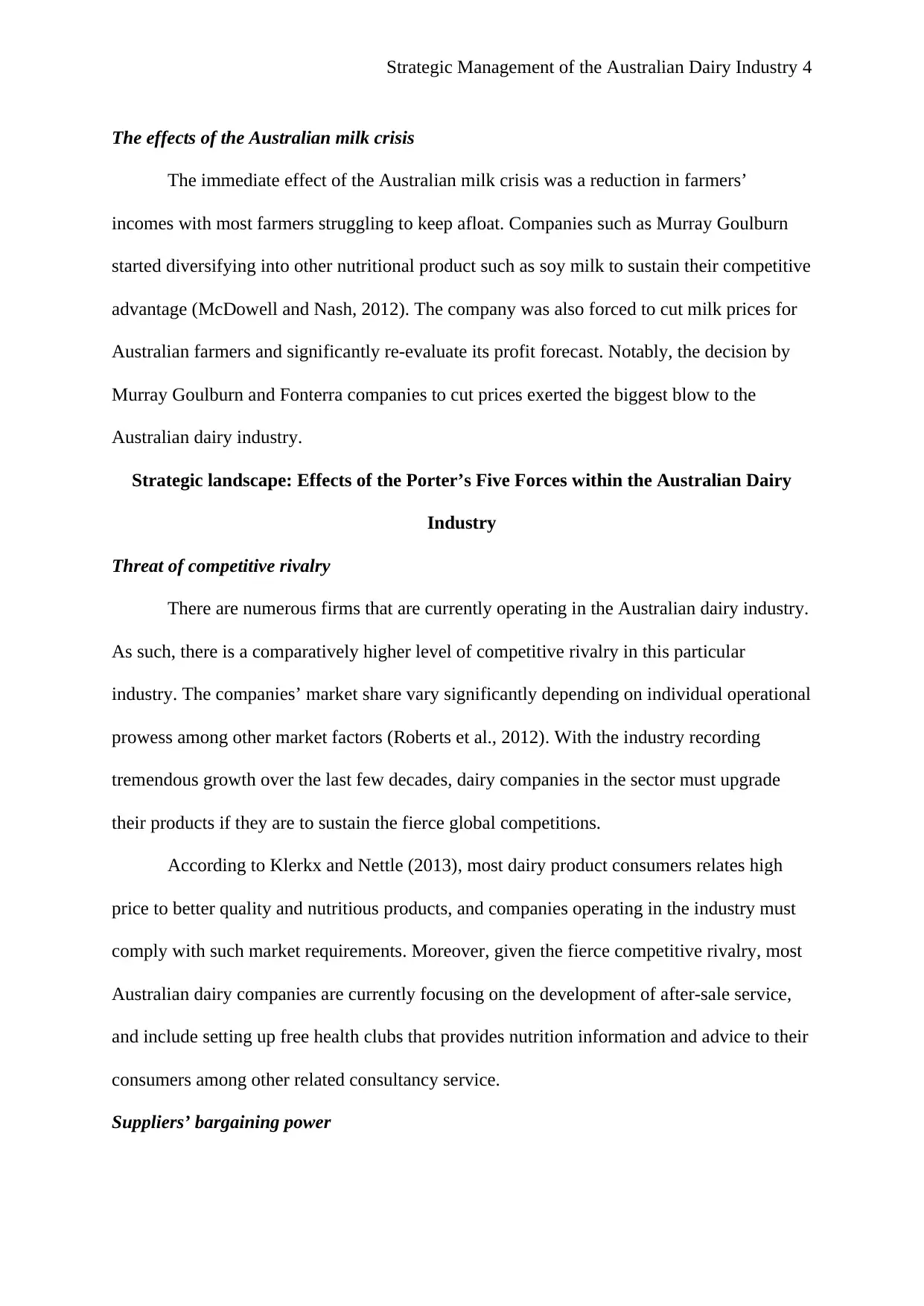
Strategic Management of the Australian Dairy Industry 4
The effects of the Australian milk crisis
The immediate effect of the Australian milk crisis was a reduction in farmers’
incomes with most farmers struggling to keep afloat. Companies such as Murray Goulburn
started diversifying into other nutritional product such as soy milk to sustain their competitive
advantage (McDowell and Nash, 2012). The company was also forced to cut milk prices for
Australian farmers and significantly re-evaluate its profit forecast. Notably, the decision by
Murray Goulburn and Fonterra companies to cut prices exerted the biggest blow to the
Australian dairy industry.
Strategic landscape: Effects of the Porter’s Five Forces within the Australian Dairy
Industry
Threat of competitive rivalry
There are numerous firms that are currently operating in the Australian dairy industry.
As such, there is a comparatively higher level of competitive rivalry in this particular
industry. The companies’ market share vary significantly depending on individual operational
prowess among other market factors (Roberts et al., 2012). With the industry recording
tremendous growth over the last few decades, dairy companies in the sector must upgrade
their products if they are to sustain the fierce global competitions.
According to Klerkx and Nettle (2013), most dairy product consumers relates high
price to better quality and nutritious products, and companies operating in the industry must
comply with such market requirements. Moreover, given the fierce competitive rivalry, most
Australian dairy companies are currently focusing on the development of after-sale service,
and include setting up free health clubs that provides nutrition information and advice to their
consumers among other related consultancy service.
Suppliers’ bargaining power
The effects of the Australian milk crisis
The immediate effect of the Australian milk crisis was a reduction in farmers’
incomes with most farmers struggling to keep afloat. Companies such as Murray Goulburn
started diversifying into other nutritional product such as soy milk to sustain their competitive
advantage (McDowell and Nash, 2012). The company was also forced to cut milk prices for
Australian farmers and significantly re-evaluate its profit forecast. Notably, the decision by
Murray Goulburn and Fonterra companies to cut prices exerted the biggest blow to the
Australian dairy industry.
Strategic landscape: Effects of the Porter’s Five Forces within the Australian Dairy
Industry
Threat of competitive rivalry
There are numerous firms that are currently operating in the Australian dairy industry.
As such, there is a comparatively higher level of competitive rivalry in this particular
industry. The companies’ market share vary significantly depending on individual operational
prowess among other market factors (Roberts et al., 2012). With the industry recording
tremendous growth over the last few decades, dairy companies in the sector must upgrade
their products if they are to sustain the fierce global competitions.
According to Klerkx and Nettle (2013), most dairy product consumers relates high
price to better quality and nutritious products, and companies operating in the industry must
comply with such market requirements. Moreover, given the fierce competitive rivalry, most
Australian dairy companies are currently focusing on the development of after-sale service,
and include setting up free health clubs that provides nutrition information and advice to their
consumers among other related consultancy service.
Suppliers’ bargaining power
Secure Best Marks with AI Grader
Need help grading? Try our AI Grader for instant feedback on your assignments.
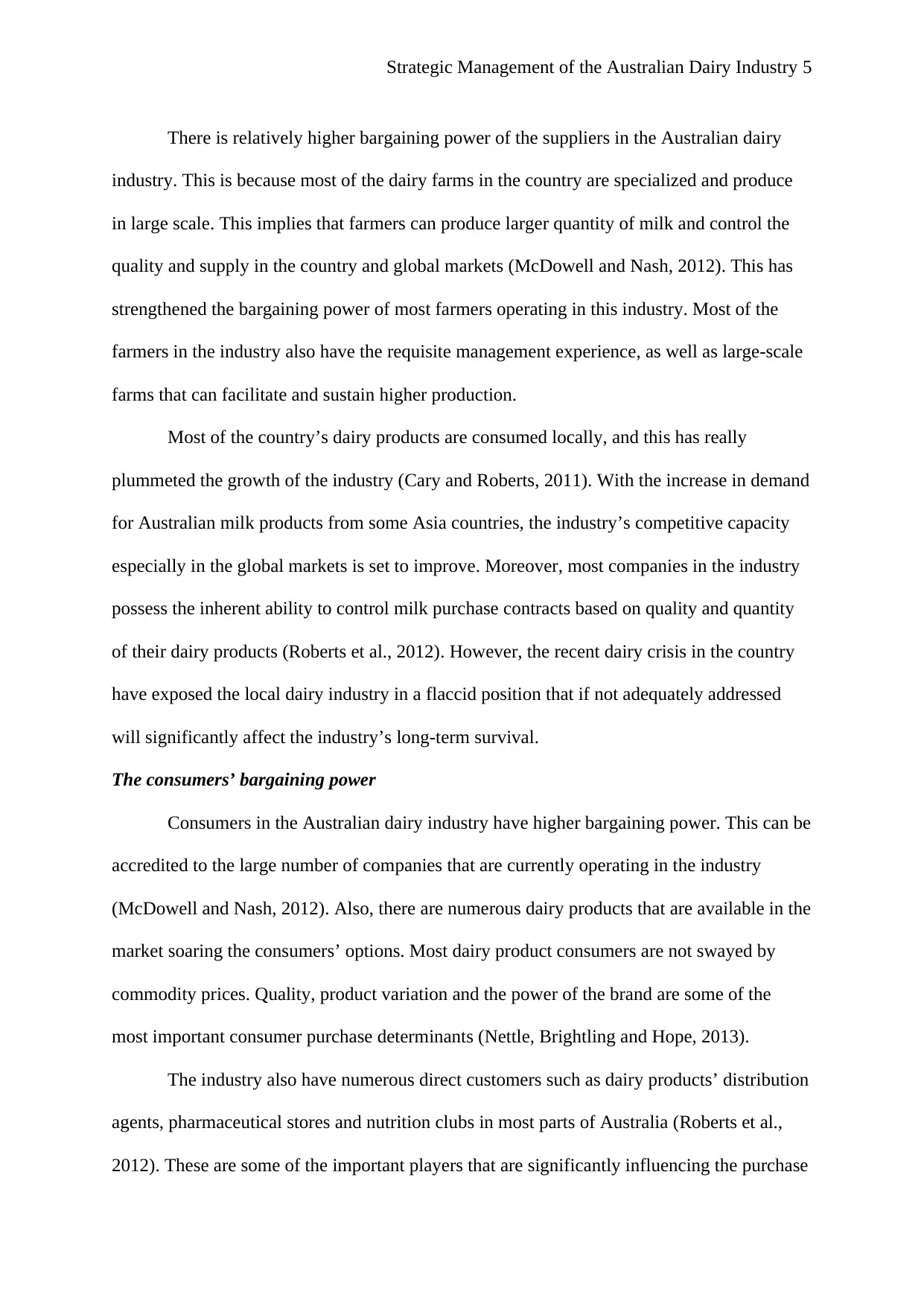
Strategic Management of the Australian Dairy Industry 5
There is relatively higher bargaining power of the suppliers in the Australian dairy
industry. This is because most of the dairy farms in the country are specialized and produce
in large scale. This implies that farmers can produce larger quantity of milk and control the
quality and supply in the country and global markets (McDowell and Nash, 2012). This has
strengthened the bargaining power of most farmers operating in this industry. Most of the
farmers in the industry also have the requisite management experience, as well as large-scale
farms that can facilitate and sustain higher production.
Most of the country’s dairy products are consumed locally, and this has really
plummeted the growth of the industry (Cary and Roberts, 2011). With the increase in demand
for Australian milk products from some Asia countries, the industry’s competitive capacity
especially in the global markets is set to improve. Moreover, most companies in the industry
possess the inherent ability to control milk purchase contracts based on quality and quantity
of their dairy products (Roberts et al., 2012). However, the recent dairy crisis in the country
have exposed the local dairy industry in a flaccid position that if not adequately addressed
will significantly affect the industry’s long-term survival.
The consumers’ bargaining power
Consumers in the Australian dairy industry have higher bargaining power. This can be
accredited to the large number of companies that are currently operating in the industry
(McDowell and Nash, 2012). Also, there are numerous dairy products that are available in the
market soaring the consumers’ options. Most dairy product consumers are not swayed by
commodity prices. Quality, product variation and the power of the brand are some of the
most important consumer purchase determinants (Nettle, Brightling and Hope, 2013).
The industry also have numerous direct customers such as dairy products’ distribution
agents, pharmaceutical stores and nutrition clubs in most parts of Australia (Roberts et al.,
2012). These are some of the important players that are significantly influencing the purchase
There is relatively higher bargaining power of the suppliers in the Australian dairy
industry. This is because most of the dairy farms in the country are specialized and produce
in large scale. This implies that farmers can produce larger quantity of milk and control the
quality and supply in the country and global markets (McDowell and Nash, 2012). This has
strengthened the bargaining power of most farmers operating in this industry. Most of the
farmers in the industry also have the requisite management experience, as well as large-scale
farms that can facilitate and sustain higher production.
Most of the country’s dairy products are consumed locally, and this has really
plummeted the growth of the industry (Cary and Roberts, 2011). With the increase in demand
for Australian milk products from some Asia countries, the industry’s competitive capacity
especially in the global markets is set to improve. Moreover, most companies in the industry
possess the inherent ability to control milk purchase contracts based on quality and quantity
of their dairy products (Roberts et al., 2012). However, the recent dairy crisis in the country
have exposed the local dairy industry in a flaccid position that if not adequately addressed
will significantly affect the industry’s long-term survival.
The consumers’ bargaining power
Consumers in the Australian dairy industry have higher bargaining power. This can be
accredited to the large number of companies that are currently operating in the industry
(McDowell and Nash, 2012). Also, there are numerous dairy products that are available in the
market soaring the consumers’ options. Most dairy product consumers are not swayed by
commodity prices. Quality, product variation and the power of the brand are some of the
most important consumer purchase determinants (Nettle, Brightling and Hope, 2013).
The industry also have numerous direct customers such as dairy products’ distribution
agents, pharmaceutical stores and nutrition clubs in most parts of Australia (Roberts et al.,
2012). These are some of the important players that are significantly influencing the purchase
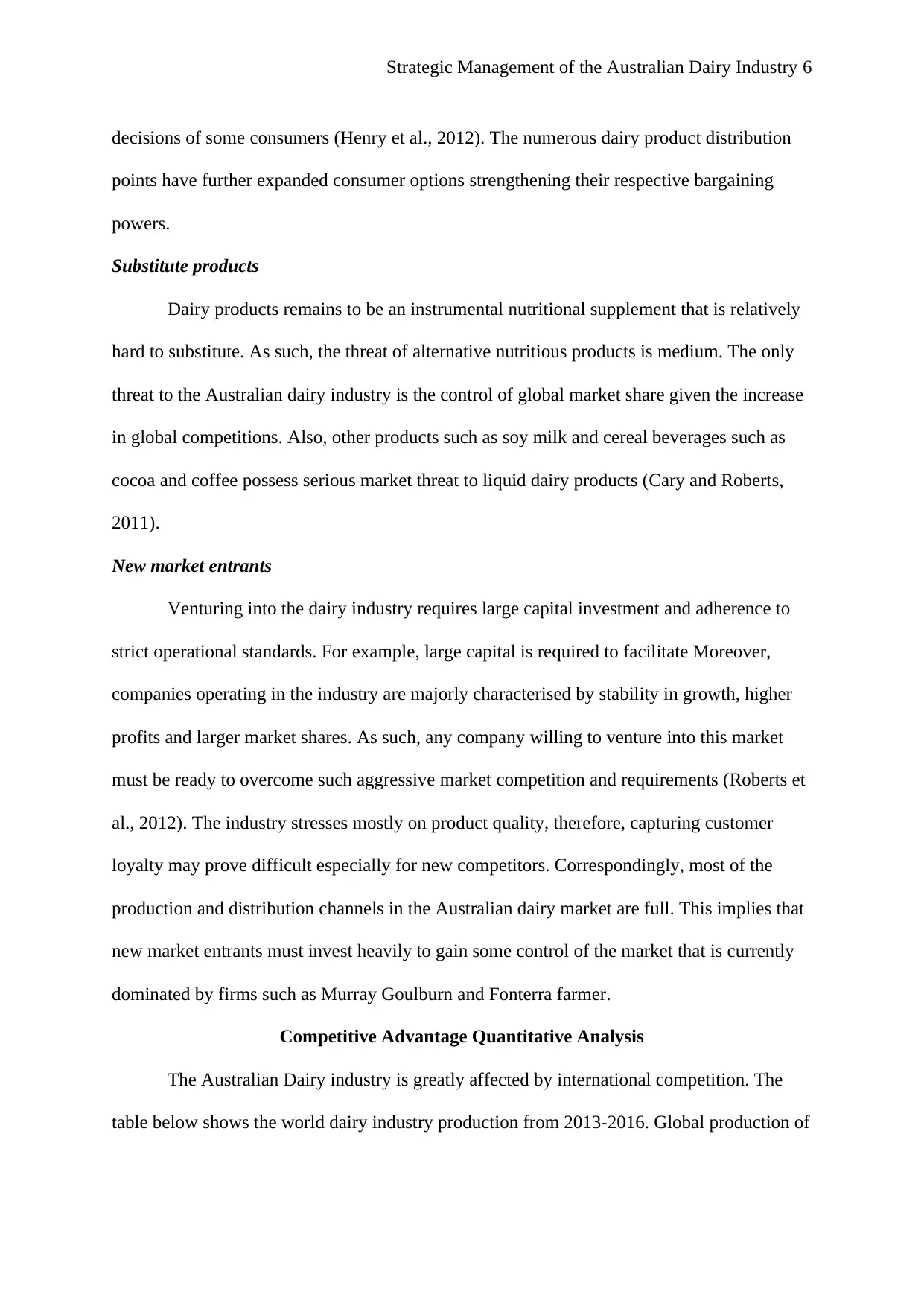
Strategic Management of the Australian Dairy Industry 6
decisions of some consumers (Henry et al., 2012). The numerous dairy product distribution
points have further expanded consumer options strengthening their respective bargaining
powers.
Substitute products
Dairy products remains to be an instrumental nutritional supplement that is relatively
hard to substitute. As such, the threat of alternative nutritious products is medium. The only
threat to the Australian dairy industry is the control of global market share given the increase
in global competitions. Also, other products such as soy milk and cereal beverages such as
cocoa and coffee possess serious market threat to liquid dairy products (Cary and Roberts,
2011).
New market entrants
Venturing into the dairy industry requires large capital investment and adherence to
strict operational standards. For example, large capital is required to facilitate Moreover,
companies operating in the industry are majorly characterised by stability in growth, higher
profits and larger market shares. As such, any company willing to venture into this market
must be ready to overcome such aggressive market competition and requirements (Roberts et
al., 2012). The industry stresses mostly on product quality, therefore, capturing customer
loyalty may prove difficult especially for new competitors. Correspondingly, most of the
production and distribution channels in the Australian dairy market are full. This implies that
new market entrants must invest heavily to gain some control of the market that is currently
dominated by firms such as Murray Goulburn and Fonterra farmer.
Competitive Advantage Quantitative Analysis
The Australian Dairy industry is greatly affected by international competition. The
table below shows the world dairy industry production from 2013-2016. Global production of
decisions of some consumers (Henry et al., 2012). The numerous dairy product distribution
points have further expanded consumer options strengthening their respective bargaining
powers.
Substitute products
Dairy products remains to be an instrumental nutritional supplement that is relatively
hard to substitute. As such, the threat of alternative nutritious products is medium. The only
threat to the Australian dairy industry is the control of global market share given the increase
in global competitions. Also, other products such as soy milk and cereal beverages such as
cocoa and coffee possess serious market threat to liquid dairy products (Cary and Roberts,
2011).
New market entrants
Venturing into the dairy industry requires large capital investment and adherence to
strict operational standards. For example, large capital is required to facilitate Moreover,
companies operating in the industry are majorly characterised by stability in growth, higher
profits and larger market shares. As such, any company willing to venture into this market
must be ready to overcome such aggressive market competition and requirements (Roberts et
al., 2012). The industry stresses mostly on product quality, therefore, capturing customer
loyalty may prove difficult especially for new competitors. Correspondingly, most of the
production and distribution channels in the Australian dairy market are full. This implies that
new market entrants must invest heavily to gain some control of the market that is currently
dominated by firms such as Murray Goulburn and Fonterra farmer.
Competitive Advantage Quantitative Analysis
The Australian Dairy industry is greatly affected by international competition. The
table below shows the world dairy industry production from 2013-2016. Global production of
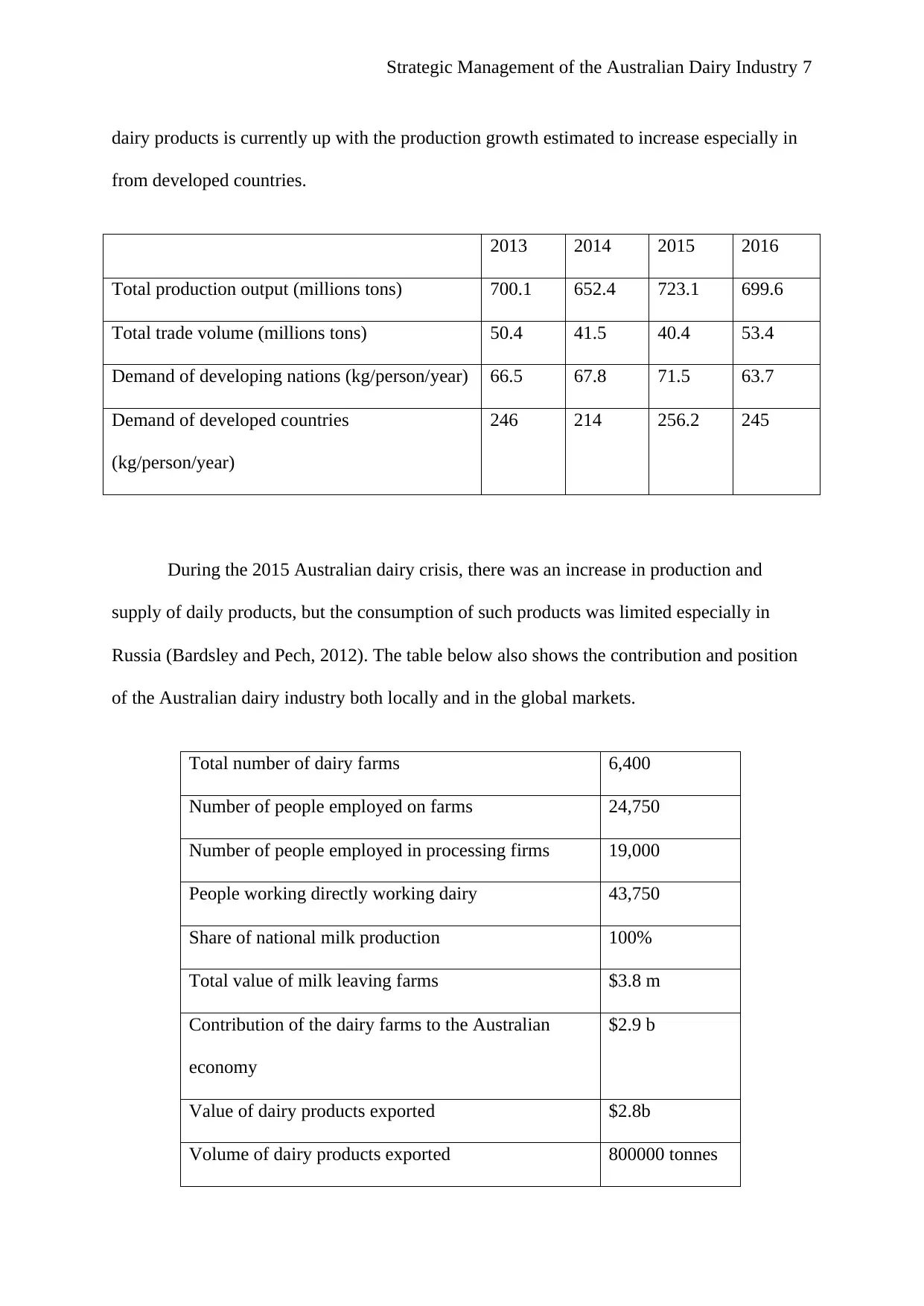
Strategic Management of the Australian Dairy Industry 7
dairy products is currently up with the production growth estimated to increase especially in
from developed countries.
2013 2014 2015 2016
Total production output (millions tons) 700.1 652.4 723.1 699.6
Total trade volume (millions tons) 50.4 41.5 40.4 53.4
Demand of developing nations (kg/person/year) 66.5 67.8 71.5 63.7
Demand of developed countries
(kg/person/year)
246 214 256.2 245
During the 2015 Australian dairy crisis, there was an increase in production and
supply of daily products, but the consumption of such products was limited especially in
Russia (Bardsley and Pech, 2012). The table below also shows the contribution and position
of the Australian dairy industry both locally and in the global markets.
Total number of dairy farms 6,400
Number of people employed on farms 24,750
Number of people employed in processing firms 19,000
People working directly working dairy 43,750
Share of national milk production 100%
Total value of milk leaving farms $3.8 m
Contribution of the dairy farms to the Australian
economy
$2.9 b
Value of dairy products exported $2.8b
Volume of dairy products exported 800000 tonnes
dairy products is currently up with the production growth estimated to increase especially in
from developed countries.
2013 2014 2015 2016
Total production output (millions tons) 700.1 652.4 723.1 699.6
Total trade volume (millions tons) 50.4 41.5 40.4 53.4
Demand of developing nations (kg/person/year) 66.5 67.8 71.5 63.7
Demand of developed countries
(kg/person/year)
246 214 256.2 245
During the 2015 Australian dairy crisis, there was an increase in production and
supply of daily products, but the consumption of such products was limited especially in
Russia (Bardsley and Pech, 2012). The table below also shows the contribution and position
of the Australian dairy industry both locally and in the global markets.
Total number of dairy farms 6,400
Number of people employed on farms 24,750
Number of people employed in processing firms 19,000
People working directly working dairy 43,750
Share of national milk production 100%
Total value of milk leaving farms $3.8 m
Contribution of the dairy farms to the Australian
economy
$2.9 b
Value of dairy products exported $2.8b
Volume of dairy products exported 800000 tonnes
Paraphrase This Document
Need a fresh take? Get an instant paraphrase of this document with our AI Paraphraser
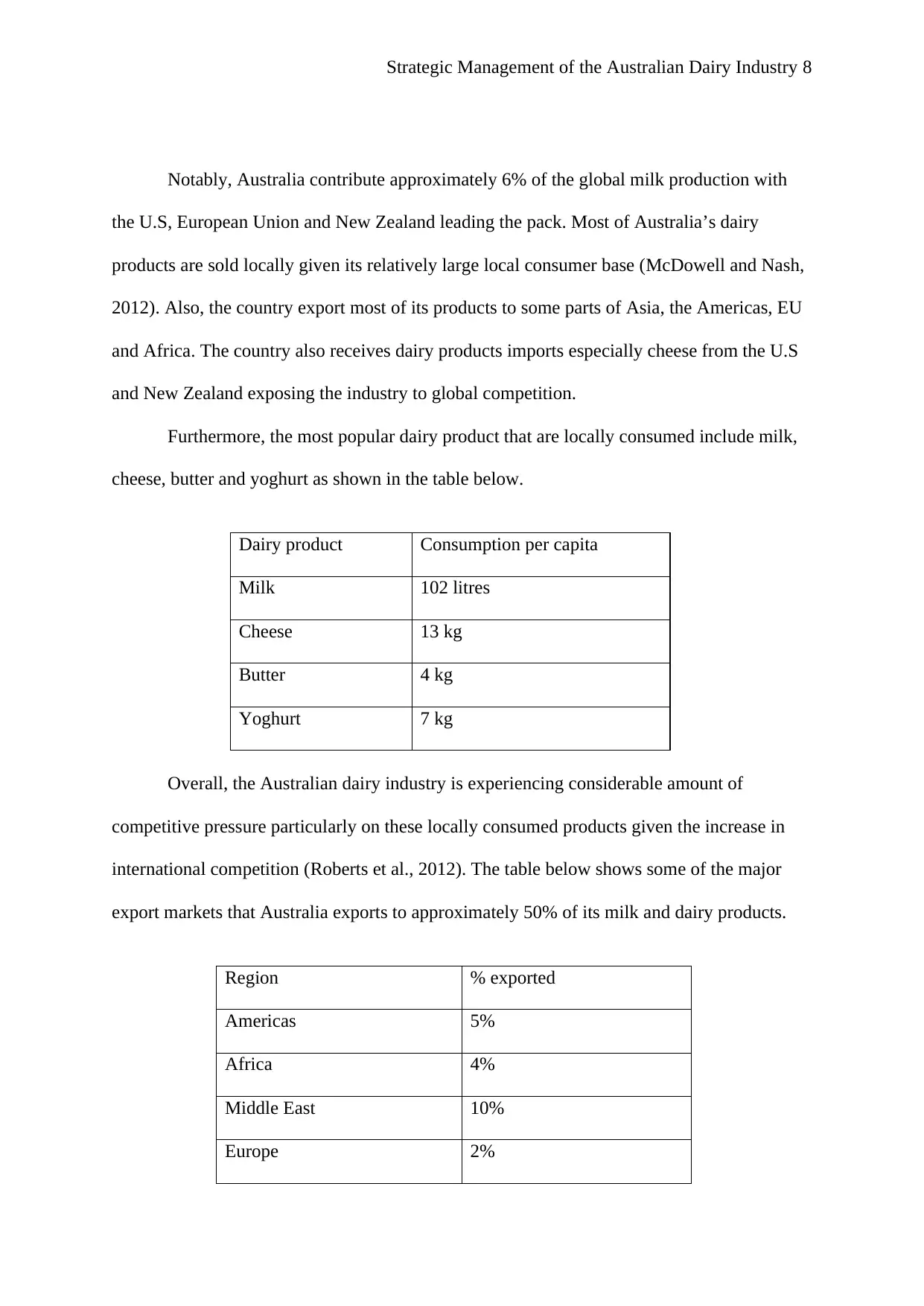
Strategic Management of the Australian Dairy Industry 8
Notably, Australia contribute approximately 6% of the global milk production with
the U.S, European Union and New Zealand leading the pack. Most of Australia’s dairy
products are sold locally given its relatively large local consumer base (McDowell and Nash,
2012). Also, the country export most of its products to some parts of Asia, the Americas, EU
and Africa. The country also receives dairy products imports especially cheese from the U.S
and New Zealand exposing the industry to global competition.
Furthermore, the most popular dairy product that are locally consumed include milk,
cheese, butter and yoghurt as shown in the table below.
Dairy product Consumption per capita
Milk 102 litres
Cheese 13 kg
Butter 4 kg
Yoghurt 7 kg
Overall, the Australian dairy industry is experiencing considerable amount of
competitive pressure particularly on these locally consumed products given the increase in
international competition (Roberts et al., 2012). The table below shows some of the major
export markets that Australia exports to approximately 50% of its milk and dairy products.
Region % exported
Americas 5%
Africa 4%
Middle East 10%
Europe 2%
Notably, Australia contribute approximately 6% of the global milk production with
the U.S, European Union and New Zealand leading the pack. Most of Australia’s dairy
products are sold locally given its relatively large local consumer base (McDowell and Nash,
2012). Also, the country export most of its products to some parts of Asia, the Americas, EU
and Africa. The country also receives dairy products imports especially cheese from the U.S
and New Zealand exposing the industry to global competition.
Furthermore, the most popular dairy product that are locally consumed include milk,
cheese, butter and yoghurt as shown in the table below.
Dairy product Consumption per capita
Milk 102 litres
Cheese 13 kg
Butter 4 kg
Yoghurt 7 kg
Overall, the Australian dairy industry is experiencing considerable amount of
competitive pressure particularly on these locally consumed products given the increase in
international competition (Roberts et al., 2012). The table below shows some of the major
export markets that Australia exports to approximately 50% of its milk and dairy products.
Region % exported
Americas 5%
Africa 4%
Middle East 10%
Europe 2%
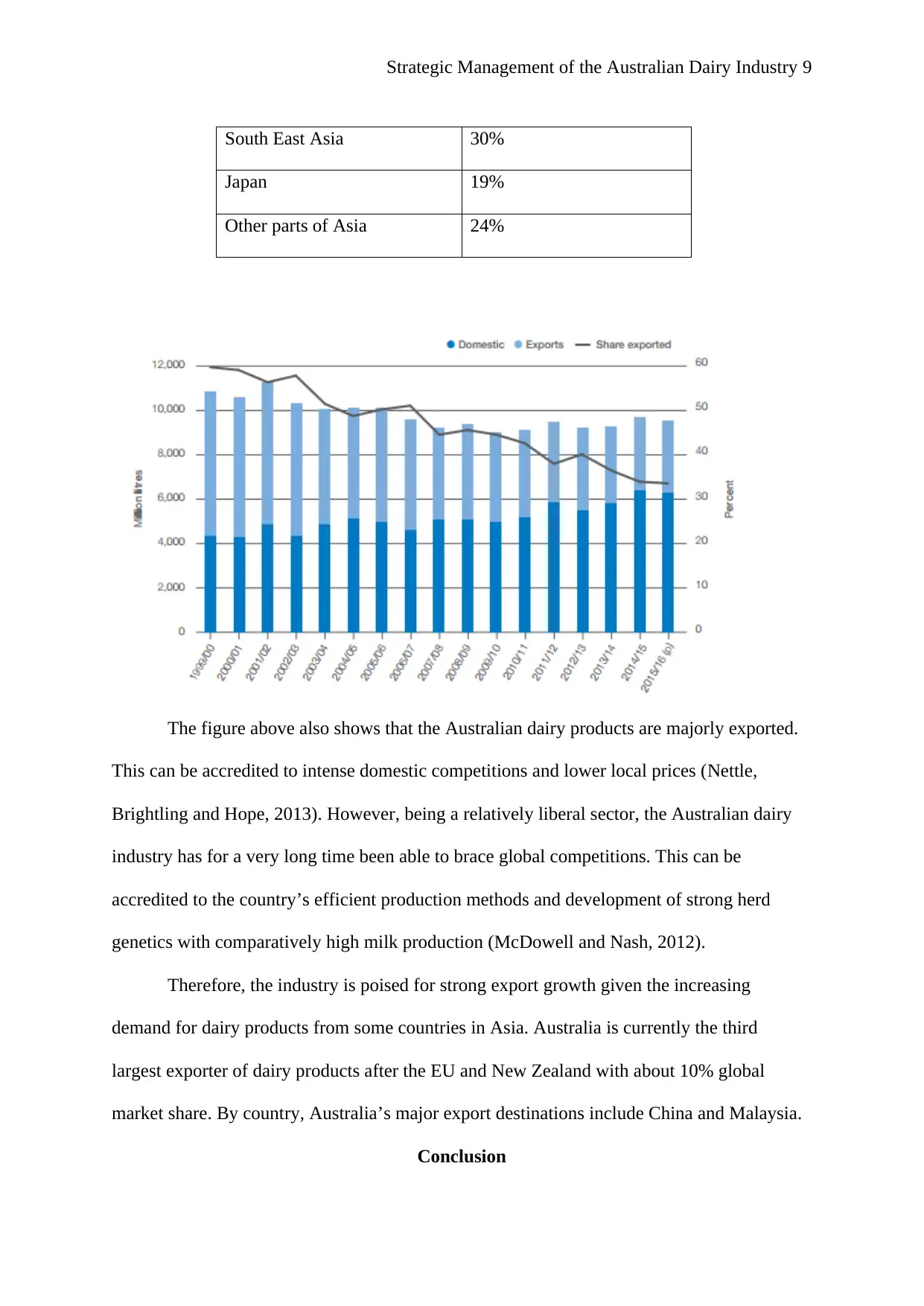
Strategic Management of the Australian Dairy Industry 9
South East Asia 30%
Japan 19%
Other parts of Asia 24%
The figure above also shows that the Australian dairy products are majorly exported.
This can be accredited to intense domestic competitions and lower local prices (Nettle,
Brightling and Hope, 2013). However, being a relatively liberal sector, the Australian dairy
industry has for a very long time been able to brace global competitions. This can be
accredited to the country’s efficient production methods and development of strong herd
genetics with comparatively high milk production (McDowell and Nash, 2012).
Therefore, the industry is poised for strong export growth given the increasing
demand for dairy products from some countries in Asia. Australia is currently the third
largest exporter of dairy products after the EU and New Zealand with about 10% global
market share. By country, Australia’s major export destinations include China and Malaysia.
Conclusion
South East Asia 30%
Japan 19%
Other parts of Asia 24%
The figure above also shows that the Australian dairy products are majorly exported.
This can be accredited to intense domestic competitions and lower local prices (Nettle,
Brightling and Hope, 2013). However, being a relatively liberal sector, the Australian dairy
industry has for a very long time been able to brace global competitions. This can be
accredited to the country’s efficient production methods and development of strong herd
genetics with comparatively high milk production (McDowell and Nash, 2012).
Therefore, the industry is poised for strong export growth given the increasing
demand for dairy products from some countries in Asia. Australia is currently the third
largest exporter of dairy products after the EU and New Zealand with about 10% global
market share. By country, Australia’s major export destinations include China and Malaysia.
Conclusion
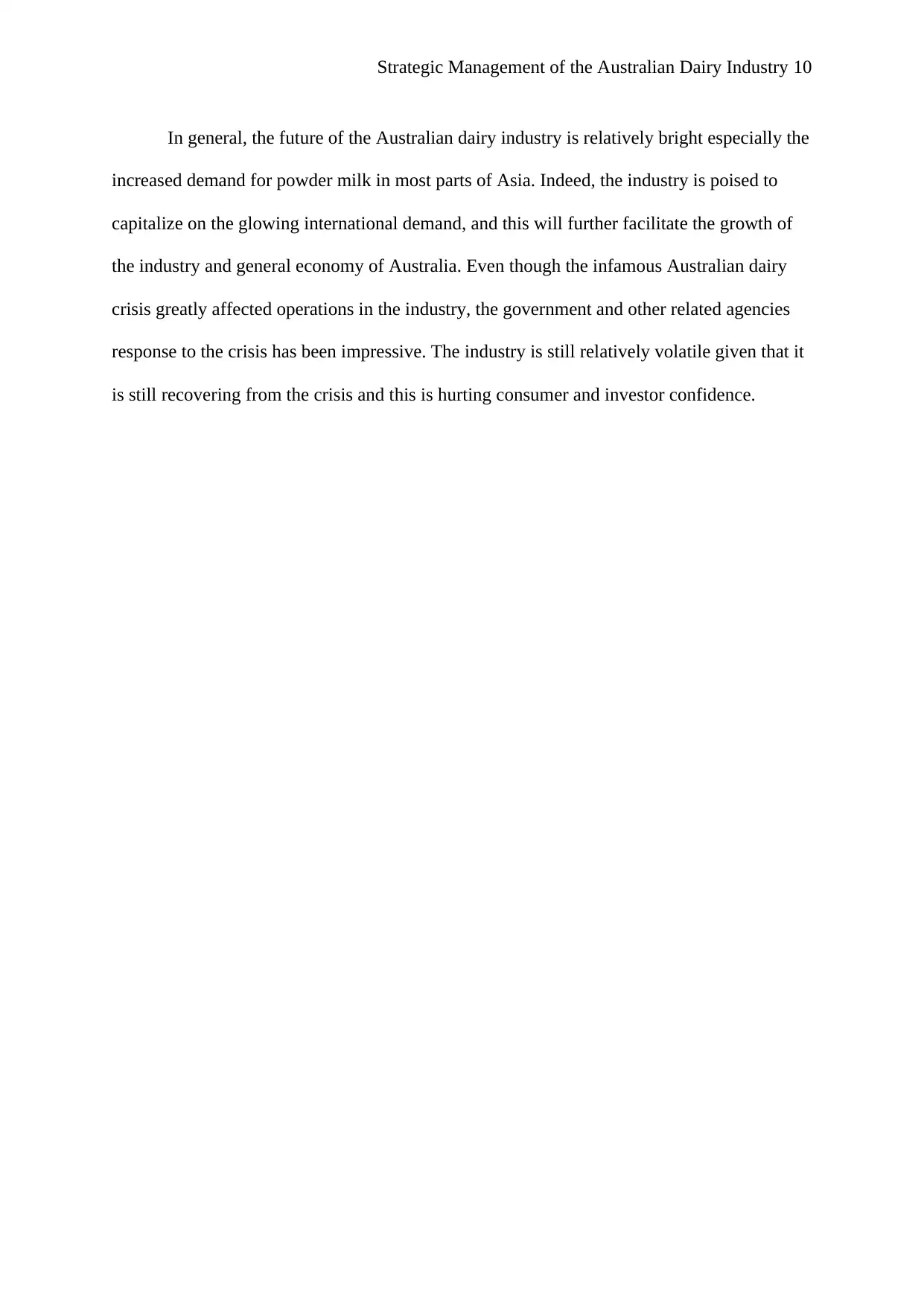
Strategic Management of the Australian Dairy Industry 10
In general, the future of the Australian dairy industry is relatively bright especially the
increased demand for powder milk in most parts of Asia. Indeed, the industry is poised to
capitalize on the glowing international demand, and this will further facilitate the growth of
the industry and general economy of Australia. Even though the infamous Australian dairy
crisis greatly affected operations in the industry, the government and other related agencies
response to the crisis has been impressive. The industry is still relatively volatile given that it
is still recovering from the crisis and this is hurting consumer and investor confidence.
In general, the future of the Australian dairy industry is relatively bright especially the
increased demand for powder milk in most parts of Asia. Indeed, the industry is poised to
capitalize on the glowing international demand, and this will further facilitate the growth of
the industry and general economy of Australia. Even though the infamous Australian dairy
crisis greatly affected operations in the industry, the government and other related agencies
response to the crisis has been impressive. The industry is still relatively volatile given that it
is still recovering from the crisis and this is hurting consumer and investor confidence.
Secure Best Marks with AI Grader
Need help grading? Try our AI Grader for instant feedback on your assignments.
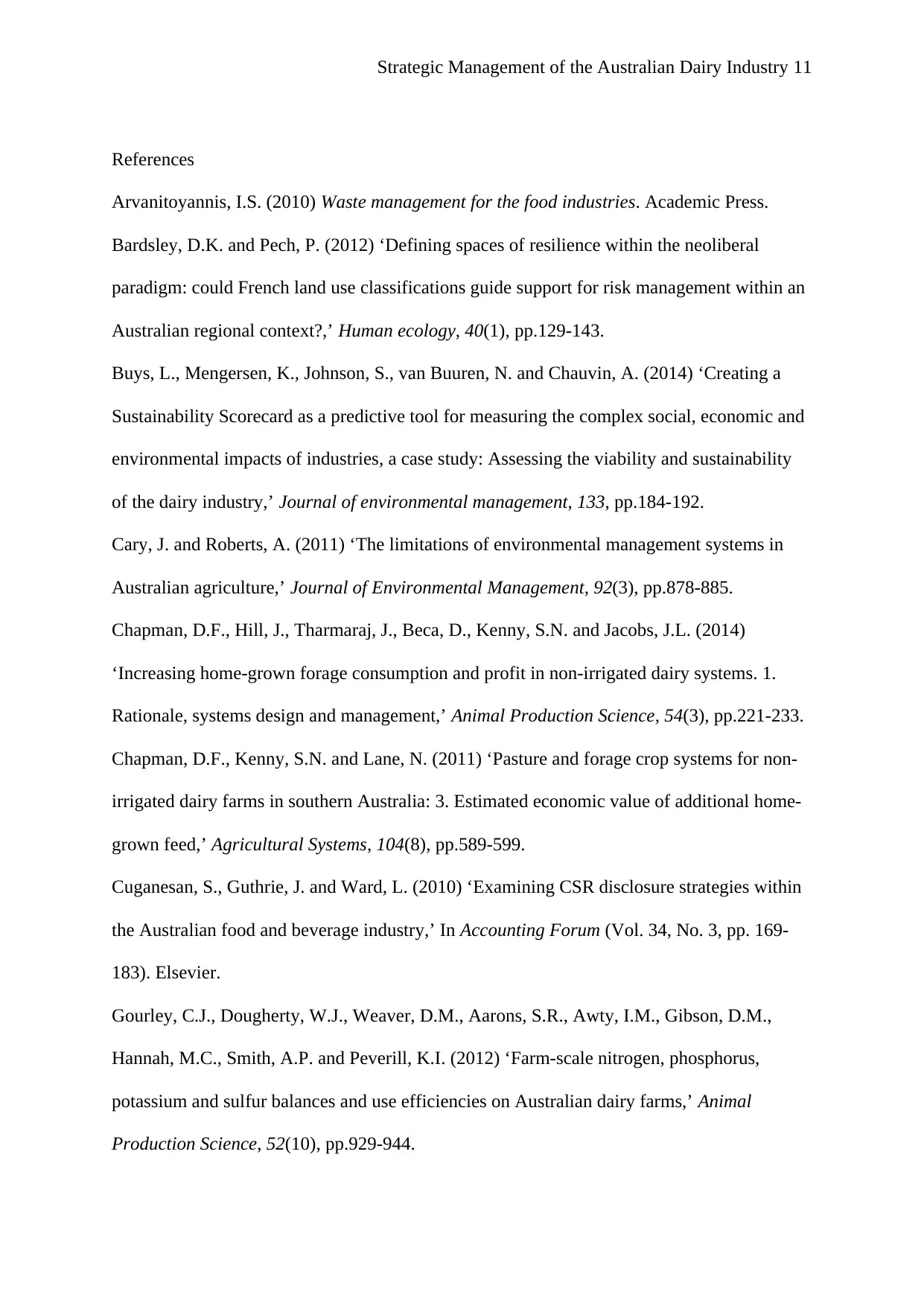
Strategic Management of the Australian Dairy Industry 11
References
Arvanitoyannis, I.S. (2010) Waste management for the food industries. Academic Press.
Bardsley, D.K. and Pech, P. (2012) ‘Defining spaces of resilience within the neoliberal
paradigm: could French land use classifications guide support for risk management within an
Australian regional context?,’ Human ecology, 40(1), pp.129-143.
Buys, L., Mengersen, K., Johnson, S., van Buuren, N. and Chauvin, A. (2014) ‘Creating a
Sustainability Scorecard as a predictive tool for measuring the complex social, economic and
environmental impacts of industries, a case study: Assessing the viability and sustainability
of the dairy industry,’ Journal of environmental management, 133, pp.184-192.
Cary, J. and Roberts, A. (2011) ‘The limitations of environmental management systems in
Australian agriculture,’ Journal of Environmental Management, 92(3), pp.878-885.
Chapman, D.F., Hill, J., Tharmaraj, J., Beca, D., Kenny, S.N. and Jacobs, J.L. (2014)
‘Increasing home-grown forage consumption and profit in non-irrigated dairy systems. 1.
Rationale, systems design and management,’ Animal Production Science, 54(3), pp.221-233.
Chapman, D.F., Kenny, S.N. and Lane, N. (2011) ‘Pasture and forage crop systems for non-
irrigated dairy farms in southern Australia: 3. Estimated economic value of additional home-
grown feed,’ Agricultural Systems, 104(8), pp.589-599.
Cuganesan, S., Guthrie, J. and Ward, L. (2010) ‘Examining CSR disclosure strategies within
the Australian food and beverage industry,’ In Accounting Forum (Vol. 34, No. 3, pp. 169-
183). Elsevier.
Gourley, C.J., Dougherty, W.J., Weaver, D.M., Aarons, S.R., Awty, I.M., Gibson, D.M.,
Hannah, M.C., Smith, A.P. and Peverill, K.I. (2012) ‘Farm-scale nitrogen, phosphorus,
potassium and sulfur balances and use efficiencies on Australian dairy farms,’ Animal
Production Science, 52(10), pp.929-944.
References
Arvanitoyannis, I.S. (2010) Waste management for the food industries. Academic Press.
Bardsley, D.K. and Pech, P. (2012) ‘Defining spaces of resilience within the neoliberal
paradigm: could French land use classifications guide support for risk management within an
Australian regional context?,’ Human ecology, 40(1), pp.129-143.
Buys, L., Mengersen, K., Johnson, S., van Buuren, N. and Chauvin, A. (2014) ‘Creating a
Sustainability Scorecard as a predictive tool for measuring the complex social, economic and
environmental impacts of industries, a case study: Assessing the viability and sustainability
of the dairy industry,’ Journal of environmental management, 133, pp.184-192.
Cary, J. and Roberts, A. (2011) ‘The limitations of environmental management systems in
Australian agriculture,’ Journal of Environmental Management, 92(3), pp.878-885.
Chapman, D.F., Hill, J., Tharmaraj, J., Beca, D., Kenny, S.N. and Jacobs, J.L. (2014)
‘Increasing home-grown forage consumption and profit in non-irrigated dairy systems. 1.
Rationale, systems design and management,’ Animal Production Science, 54(3), pp.221-233.
Chapman, D.F., Kenny, S.N. and Lane, N. (2011) ‘Pasture and forage crop systems for non-
irrigated dairy farms in southern Australia: 3. Estimated economic value of additional home-
grown feed,’ Agricultural Systems, 104(8), pp.589-599.
Cuganesan, S., Guthrie, J. and Ward, L. (2010) ‘Examining CSR disclosure strategies within
the Australian food and beverage industry,’ In Accounting Forum (Vol. 34, No. 3, pp. 169-
183). Elsevier.
Gourley, C.J., Dougherty, W.J., Weaver, D.M., Aarons, S.R., Awty, I.M., Gibson, D.M.,
Hannah, M.C., Smith, A.P. and Peverill, K.I. (2012) ‘Farm-scale nitrogen, phosphorus,
potassium and sulfur balances and use efficiencies on Australian dairy farms,’ Animal
Production Science, 52(10), pp.929-944.
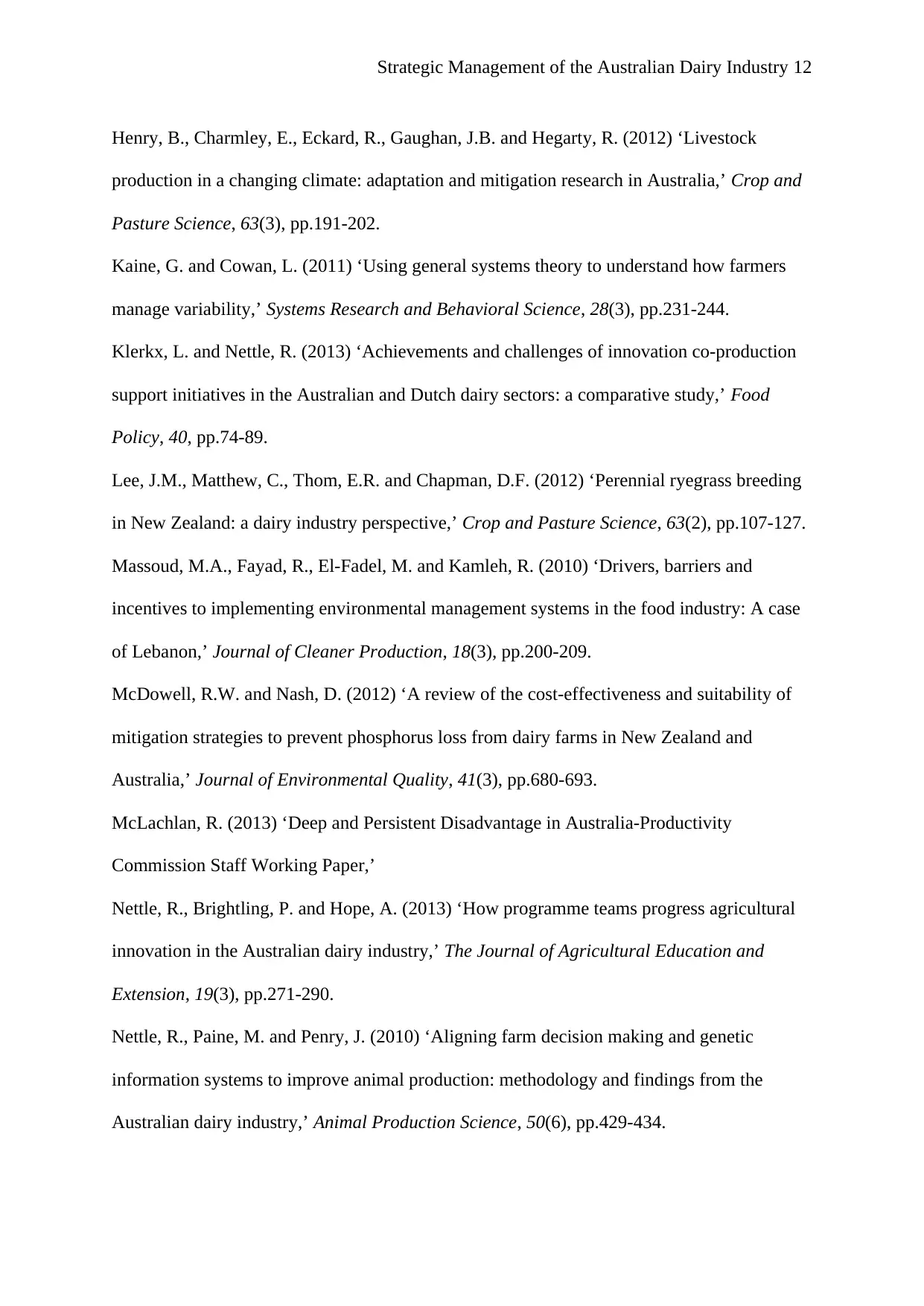
Strategic Management of the Australian Dairy Industry 12
Henry, B., Charmley, E., Eckard, R., Gaughan, J.B. and Hegarty, R. (2012) ‘Livestock
production in a changing climate: adaptation and mitigation research in Australia,’ Crop and
Pasture Science, 63(3), pp.191-202.
Kaine, G. and Cowan, L. (2011) ‘Using general systems theory to understand how farmers
manage variability,’ Systems Research and Behavioral Science, 28(3), pp.231-244.
Klerkx, L. and Nettle, R. (2013) ‘Achievements and challenges of innovation co-production
support initiatives in the Australian and Dutch dairy sectors: a comparative study,’ Food
Policy, 40, pp.74-89.
Lee, J.M., Matthew, C., Thom, E.R. and Chapman, D.F. (2012) ‘Perennial ryegrass breeding
in New Zealand: a dairy industry perspective,’ Crop and Pasture Science, 63(2), pp.107-127.
Massoud, M.A., Fayad, R., El-Fadel, M. and Kamleh, R. (2010) ‘Drivers, barriers and
incentives to implementing environmental management systems in the food industry: A case
of Lebanon,’ Journal of Cleaner Production, 18(3), pp.200-209.
McDowell, R.W. and Nash, D. (2012) ‘A review of the cost-effectiveness and suitability of
mitigation strategies to prevent phosphorus loss from dairy farms in New Zealand and
Australia,’ Journal of Environmental Quality, 41(3), pp.680-693.
McLachlan, R. (2013) ‘Deep and Persistent Disadvantage in Australia-Productivity
Commission Staff Working Paper,’
Nettle, R., Brightling, P. and Hope, A. (2013) ‘How programme teams progress agricultural
innovation in the Australian dairy industry,’ The Journal of Agricultural Education and
Extension, 19(3), pp.271-290.
Nettle, R., Paine, M. and Penry, J. (2010) ‘Aligning farm decision making and genetic
information systems to improve animal production: methodology and findings from the
Australian dairy industry,’ Animal Production Science, 50(6), pp.429-434.
Henry, B., Charmley, E., Eckard, R., Gaughan, J.B. and Hegarty, R. (2012) ‘Livestock
production in a changing climate: adaptation and mitigation research in Australia,’ Crop and
Pasture Science, 63(3), pp.191-202.
Kaine, G. and Cowan, L. (2011) ‘Using general systems theory to understand how farmers
manage variability,’ Systems Research and Behavioral Science, 28(3), pp.231-244.
Klerkx, L. and Nettle, R. (2013) ‘Achievements and challenges of innovation co-production
support initiatives in the Australian and Dutch dairy sectors: a comparative study,’ Food
Policy, 40, pp.74-89.
Lee, J.M., Matthew, C., Thom, E.R. and Chapman, D.F. (2012) ‘Perennial ryegrass breeding
in New Zealand: a dairy industry perspective,’ Crop and Pasture Science, 63(2), pp.107-127.
Massoud, M.A., Fayad, R., El-Fadel, M. and Kamleh, R. (2010) ‘Drivers, barriers and
incentives to implementing environmental management systems in the food industry: A case
of Lebanon,’ Journal of Cleaner Production, 18(3), pp.200-209.
McDowell, R.W. and Nash, D. (2012) ‘A review of the cost-effectiveness and suitability of
mitigation strategies to prevent phosphorus loss from dairy farms in New Zealand and
Australia,’ Journal of Environmental Quality, 41(3), pp.680-693.
McLachlan, R. (2013) ‘Deep and Persistent Disadvantage in Australia-Productivity
Commission Staff Working Paper,’
Nettle, R., Brightling, P. and Hope, A. (2013) ‘How programme teams progress agricultural
innovation in the Australian dairy industry,’ The Journal of Agricultural Education and
Extension, 19(3), pp.271-290.
Nettle, R., Paine, M. and Penry, J. (2010) ‘Aligning farm decision making and genetic
information systems to improve animal production: methodology and findings from the
Australian dairy industry,’ Animal Production Science, 50(6), pp.429-434.
1 out of 12
Related Documents
Your All-in-One AI-Powered Toolkit for Academic Success.
+13062052269
info@desklib.com
Available 24*7 on WhatsApp / Email
![[object Object]](/_next/static/media/star-bottom.7253800d.svg)
Unlock your academic potential
© 2024 | Zucol Services PVT LTD | All rights reserved.





